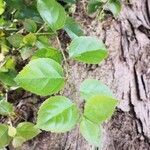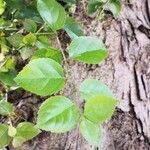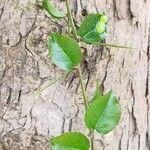Trees to 25 m tall. Bark of old branches exfoliating. Young branches reddish brown, glabrous, with pale lenticels. Leaves usually 30-50 cm; petiole cylindric, 4.5-7 cm; leaflets 10-16; petiolules 4-8 mm; leaflet blades ovate to oblong-lanceolate, 7-12 × 3-5 cm, papery, both surfaces glabrous or abaxially pubescent, secondary veins 10-15 on each side of midvein and abaxially prominent, base oblique, margin entire, apex acute to acuminate. Thyrses lax, ca. 1/2 as long as leaves, branches glabrous or subglabrous; peduncle short; bracts linear, caducous. Flowers 1.2-1.5 cm, fragrant. Pedicel short, jointed. Calyx ca. 2 mm, puberulent. Petals cream-colored to ± lavender, linear-oblong to spatulate, 12-15 × 5-6 mm. Staminal tube cylindric, glabrous, apex truncate; anthers 10, oblong, inserted near apex of tube. Ovary on a short disk, elongate, covered with trichomes; style cylindric, short, thick, covered with trichomes; stigma as high as anthers, capitate, apically 3-lobed. Capsule yellowish gray to brown, subglobose to oblong, ca. 4.5 × 3.5-4 cm, usually 3-valved, woody, surface coarse and verrucose, many seeded. Seeds flat, oblong, ca. 3 × 0.5 mm, broadly winged. Fl. Apr-May, fr. Jul-Jan.
A tree. It grows 25-35 m tall. The trunk is long and straight. It can be 20 m long and 1 m across. It has a large spreading crown. The bark is dark brown and coarsely cracked. The inner bark is red. The leaves are 30-85 cm long. There are 8-13 pairs of leaflets. These are 7-13 cm long by 3-5 cm wide. They are narrowly oval and taper to the tip. Young leaves have fine hairs. There are 7-10 pairs of side veins. The flowers are 3 cm across. They are pale red but often with a red tinge on the outside. They are in branched clusters. The fruit is yellowish grey and 4 cm long. It is slightly hairy when young. It becomes wrinkled when ripe. It splits into 3 sections. It is full of winged seeds.
Deciduous tree to 40 m tall and fluted bole to 1.2 m diameter, with buttresses to 1.5 m high. Leaves 30–50 cm long; leaflets in 6–21 pairs, ovate to oblong or subfalcate, asymmetric at base, subglabrous to velutinous abaxially. Thyrses 10–30 cm long. Flowers sweetly scented. Petals 12–16 mm long, creamy or pinkish. Capsule 2.5–4 cm long, opening by 3–5 valves. Seeds 60–100 per locule, c. 1.2 cm long.




